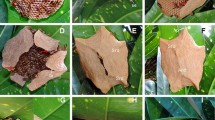Summary.
Termite workers from all families examined had no arolia (=adhesive pads) on their tarsi and are unable to climb smooth vertical surfaces such as glass or polypropylene plastic. This contrasts with ants where both workers and alates of most species possess arolia and are able to climb these surfaces. Arolia were present in alates of the majority of species investigated from three of the four most basal termite families (Mastotermitidae, Termopsidae and Kalotermitidae), though absent from the basal family Hodotermitidae that contains only three genera. Alates in the two kalotermitid species tested readily climbed glass walls. The complete evolutionary loss of arolia from alates in the specious two most apical termite families (Rhinotermitidae and Termitidae) suggests paedomorphosis. Very smooth surfaces probably cannot be used to completely prevent entry of rhinotermitid termites into buildings because these termites can eventually build galleries of feces and soil over these surfaces. However, an experiment with Coptotermes formosanus showed that a smoother surface significantly slows down the rate of gallery building.
Similar content being viewed by others
Author information
Authors and Affiliations
Corresponding author
Additional information
Received 12 February 2004; revised 17 June 2004; accepted 29 June 2004.
Rights and permissions
About this article
Cite this article
Crosland, M.W.J., Su, NY. & Scheffrahn, R.H. Arolia in termites (Isoptera): functional significance and evolutionary loss. Insectes Soc. 52, 63–66 (2005). https://doi.org/10.1007/s00040-004-0779-4
Issue Date:
DOI: https://doi.org/10.1007/s00040-004-0779-4




